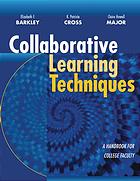There is much evidence that peer teaching and learning is a very effective way for students to learn. However, productive and enriching group learning often takes some effort to orchestrate. Assigning roles in the group or establishing ground rules can often help. These ideas and the other tips below may help your classroom group learning go smoothly.
Design Group Learning Activities to Match Learning Objectives
- Create group tasks that promote interdependence.
- Assign group work that is integral to the learning objectives you are pursuing.
- Create assignments that correlate to the students’ skills, interests, and abilities, beginning with simpler tasks early in the semester and progressing in difficulty.
- Structure tasks so that each member can equally contribute to the project.
Consider Group Membership and Size
- How groups are formed and their size should be related to the scope of the activity. Ways of assigning students to groups have various strengths and weaknesses so consider varying the method used to form groups throughout the semester.
- Ideas for forming groups
- Assign students to groups based on specific criteria such as ability, attitudes, interests, student availability. Groups can be either heterogeneous or homogeneous.
- Assign students to groups randomly.
- Have students choose their group.
- Use student self-assessment, e.g., have students rank their strengths in three or four skill areas necessary for success in the group project and then divide students accordingly.
- Use a combination of the methods above.
Encourage Students to Create an Environment of Respect within Groups
- Have students create a group learning contract outlining policies and procedures within the group such as:
- Each group member should be given the opportunity to contribute.
- People come from differing backgrounds and experiences. Differing points of view are important and should be listened to and considered in a respectful manner.
- Everyone has different learning and working styles. Some may begin discussing right away while others may hold back to process information first, therefore be supportive and don’t mistake silence for not being prepared.
- Do not interrupt others. Offer only tactful, constructive comments.
- Keep the discussion to the point. Avoid getting off on other subjects. If this happens have one person charged with getting the group back on track.
- Come to class or meetings regularly and on time.
- Come prepared and ready to share with group.
Have Students Complete These Tasks at the Beginning of Group Work
- Exchange names and, if necessary, contact details.
- Be clear as to the assignment and project deadline date.
- List all tasks needed to complete the assignment and be as specific as possible.
- Agree on who will accomplish each task and assign specific deadlines for tasks.
- Discuss important items first.
Consider Having Students Assign Roles for Group Meetings
- Assigning roles to group members may help the group work more efficiently.
- Roles to consider are chairperson, note-taker/recorder, timekeeper, presenter, etc.
- Roles are best used for short in-class activities.
Plan Strategies to Handle Individuals Dominating Discussions
- Set discussion ground rules. Examples are: no one speaking for more than three or four minutes; no interrupting; no critical comments about people.
- Suggest students elect one person to direct the discussion.
- Thank the person dominating the discussion and ask if anyone wishes to speak.
Support Students Who are Nervous about Speaking in a Group
- Ask them to jot down the point they would like to make before speaking.
- Suggest they begin by asking for an example from a classmate or agreeing with what someone said.
- Recommend taking a deep breath before speaking.
- Urge them to speak clearly.
Assess Group Learning
- Ensure that individual students know how they are progressing (e.g., encourage status reports).
- Explain how students will be graded and use a clear, noncompetitive, criterion-referenced grading design to encourage collaboration.
- Assess students on both individual and group measures.
- Consider including peer and self assessments. If conducting peer assessments have students describe in writing what each of their peers contributed to the group.
References
Barkley, E.F., Cross, K.P., & Major, C.H. (2005). Collaborative learning techniques: A handbook for college faculty. San Francisco: Jossey-Bass.
Davis, B.G. (2009). Tools for teaching (2nd ed.). San Francisco: Jossey-Bass.
Millis, B.J. (2002). Enhancing learning—and more!—Through cooperative learning. (Idea Paper #38).
Svinicki, M., & McKeachie, W.J. (2011). McKeachie’s teaching tips: Strategies, research, and theory for college and university teachers (13th ed.). Belmont, CA: Wadsworth.
Walvoord, B.E., & Anderson, V.J. (2010). Effective grading: A tool for learning and assessment in college (2nd ed.). San Francisco: Jossey-Bass.
Authored by Jennifer Beasley (February, 2005)
Revised by Terri Tarr (October, 2011)
Recommended Book

Publisher : John Wiley & Sons, Incorporated
Subject: GROUP WORK IN EDUCATION; EDUCATION / Collaborative & Team Teaching
Subtitle: A Handbook for College Faculty

